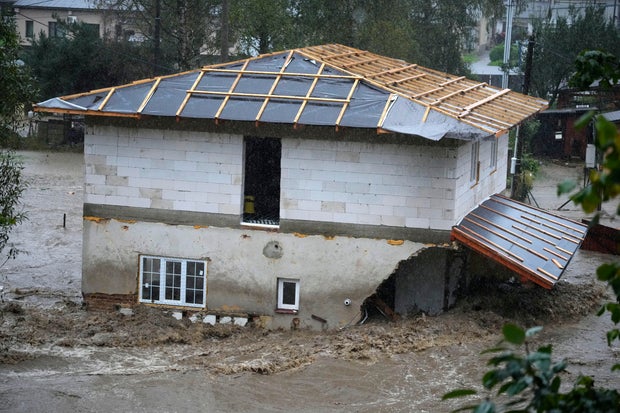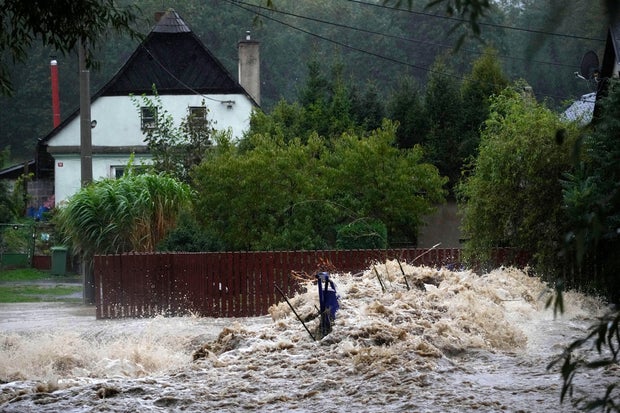CBS News
At least 8 dead, 4 missing as torrential rain and flooding hits Central Europe

The death toll was rising in Central European countries on Sunday after days of heavy rain caused widespread flooding and forced mass evacuations.
Several Central European nations have already been hit by severe flooding, including Austria, the Czech Republic, Poland and Romania. Slovakia and Hungary might come next as a result of a low pressure system from northern Italy dumping record rainfall in the region since Thursday.
Six people have died in the floods in Romania. In Austria, a firefighter died during a flood rescue, and, in Poland, one person died from drowning, the BBC reported. In the Czech Republic, police said four people were still missing after being swept away by floodwaters.
Officials declared the Austrian province that includes Vienna a disaster area, calling the weather “an unprecedented extreme situation,” while Polish Prime Minister Donald Tusk urged residents to cooperate with rescue teams in an announcement Sunday confirming the death in that country, according to the BBC.
Most parts of the Czech Republic have been affected as authorities declared the highest flood warnings at around 100 places across the country. But the situation was worst in two northeastern regions that recorded the biggest rainfall in recent days, including the Jeseniky mountains near the Polish border.
Petr David Josek / AP
In the city of Opava, up to 10,000 people out of a population of around 56,000 have been asked to leave their homes for higher ground. Rescuers used boats to transport people to safety in a neighborhood flooded by the raging Opava River.
“There’s no reason to wait,” Mayor Tomáš Navrátil told Czech public radio. He said that the situation was worse than during the last devastating floods in 1997, known as the “flood of the century.”
“We have to focus on saving lives,” Prime Minister Petr Fiala told Czech public television on Sunday. His government was set to meet Monday to assess the damages.
The worst “is not behind us yet,” the prime minister warned as the flooding made its way through the country.
President Petr Pavel sounded more optimistic, saying “it’s obvious we’ve learned a lesson from the previous crisis.”
Thousands of others also were evacuated in the towns of Krnov, which was almost completely flooded, and Cesky Tesin. The Oder River that flows to Poland was reaching extreme levels in the city of Ostrava and in Bohumin, prompting mass evacuations.
Ostrava, the regional capital is the third-largest Czech city. Its mayor, Jan Dohnal, said the city is facing major traffic disruptions in the days to come. Almost no trains were operating in the region.
Petr David Josek / AP
Towns and villages in the Jeseniky mountains, including the local center of Jesenik, were inundated and isolated by raging waters that turned roads into rivers. The military sent a helicopter to help with evacuations.
Jesenik mayor Zdenka Blistanova told Czech public television that several houses in her and other nearby towns have been destroyed by the floods. A number of bridges and roads have been also badly damaged.
About 260,000 households were without power Sunday morning in the entire country, while traffic was halted on many roads, including the major D1 highway.
A firefighter died after “slipping on stairs” while pumping out a flooded basement in the town of Tulln, the head of the fire department of Lower Austria, Dietmar Fahrafellner, told reporters on Sunday.
Authorities declared the entire state of Lower Austria in the northeastern part of the country a disaster zone, while 10,000 relief forces have so far evacuated 1,100 houses there. Emergency personnel have started setting up emergency accommodation for residents who had to flee their homes due to the flooding.
Krzysztof Zatycki / AP
Addressing reporters after a crisis meeting at the interior ministry in Vienna on Saturday afternoon, Austrian Chancellor Karl Nehammer said the situation “continues to worsen.”
He said 2,400 soldiers were ready to support the relief effort in Austria. Of those, 1,000 soldiers will deploy to the disaster zone in Lower Austria, where dams were beginning to burst.
Nehammer was expected to visit the disaster zone in Lower Austria later Sunday.
“We are experiencing difficult and dramatic hours in Lower Austria. For many people in Lower Austria these will probably be the most difficult hours of their lives,” said Johanna Mikl-Leitner, the governor of Lower Austria.
Austrian Chancellor Karl Nehammer, who was on his way to the disaster zone in Lower Austria, said that 2,400 soldiers were ready to support the relief effort.
In Vienna, the Wien River overflowed its banks, flooding homes and forcing first evacuations of houses in the river’s proximity.
Heinz-Peter Bader / AP
Romanian authorities said Sunday that another two people had died in the hard-hit eastern county of Galati after four were reported dead there a day earlier, following unprecedented rain.
In Poland, one person was presumed dead in floods in the southwest, Prime Minister Donald Tusk said Sunday.
Tusk said the situation was “dramatic” around the town of Klodzko, with about 25,000 residents, located in a valley in the Sudetes mountains near the border with the Czech Republic. Helicopters were used to pick up people from roofs in a few cases.
In Glucholazy, rising waters overflowed a river embankment and flooded streets and houses. Mayor Paweł Szymkowicz said, “we are drowning,” and appealed to residents to evacuate to high ground.
A threatened bridge in the town collapsed under the flood pressure and a police station building was knocked down in Stronie Śląskie, after floodwaters burst through the town’s dam. Submerged cars could be seen in many places in the Kłodzko Valley region bordering the Czech Republic, while a new flood wave was expected there.
Energy supplies and communications were cut off in some flooded areas, and regions may resort to using the satellite-based Starlink service, Tusk said.
The weather change arrived following a hot start to September in the region. Scientists have documented Earth’s hottest summer, breaking a record set just a year ago.
A hotter atmosphere, driven by human-caused climate change, can lead to more intense rainfall.
CBS News
House to vote on Mike Johnson’s spending plan to avoid a government shutdown

Watch CBS News
Be the first to know
Get browser notifications for breaking news, live events, and exclusive reporting.
CBS News
How much will an $850,000 mortgage cost per month?

Getty Images
Even though mortgage interest rates surged in recent years, they did little to drop home values. Instead, home prices have remained steady and even grown in many parts of the country. Now, with a major cut to the federal funds rate already issued and additional ones possible for the months ahead, prices could rise again as sellers try to take advantage of a wider pool of buyers. Homes that had been priced in the $700,000 range, for example, could now be around $800,000 or $850,000. And homes priced at $1 million or more are already growing.
Understanding this reality, then, buyers should start preparing for higher home prices now. One of the best ways to do so is by calculating the potential monthly costs of a mortgage loan. Below, we’ll detail what an $850,000 mortgage will cost per month – and what it could look like if interest rates decline as anticipated.
See what mortgage interest rate you could lock in here now.
How much will a $850,000 mortgage cost per month?
The average mortgage rate on a 30-year mortgage dropped to 6.15% this week, the lowest it’s been in two years (September 2022). But with rate cuts possible for November and when the Fed meets again in December that rate could fall again before the year ends – assuming lenders don’t start pricing in a series of presumed rate cuts to come.
Here’s what an $850,000 mortgage loan would cost per month at the rate available today, assuming the conventional 20% down payment ($170,000), minus any taxes or insurance costs:
- 30-year mortgage at 6.15%: $4,142.75 per month
- 15-year mortgage at 5.65%: $5,610.44 per month
While today’s mortgage rates aren’t likely to fall directly in tandem with the federal funds rate, a half a percentage point reduction seems possible now following the Fed’s moves this week. Here’s what those payments could fall to assuming a half a percentage point reduction between now and January.
- 30-year mortgage at 5.65%: $3,925.20 per month
- 15-year mortgage at 5.15%: $5,430.68 per month
It’s important to remember, however, that mortgage interest rates change daily (except for weekends and holidays). And in today’s evolving rate climate, these rates could fall even further than many anticipate, thus making an $850,000 mortgage loan even more affordable. So keep an eye on the market and be prepared to lock in a low rate when found.
Start shopping for rates and lenders here now.
Other factors to account for
While the above numbers reflect what buyers can expect to pay for an $850,000 mortgage now (and after a rate reduction of half a percentage point), they’re not the only factor that should be added in when trying to pinpoint your exact monthly mortgage payment. Specifically, don’t forget:
- Homeowners insurance: The bank will want their loan protected and you’ll want to be insured against theft, damage and injuries. Start shopping around now to find the best deal and consider “bundling” any policy with your car insurance to reduce costs.
- Flood insurance: Depending on where your home is located, the lender may require flood insurance proof before signing off on the loan. So be sure to ask if the home is located in a flood zone and ask if you can assume the existing policy, if applicable.
- Taxes: Taxes could be paid annually or you can have them divided among your monthly mortgage payments but this could be a significant amount of money to account for so be sure to determine the exact cost before closing, and, ideally, before making a formal offer.
- Private mortgage insurance: Don’t have enough money to make the conventional 20% down payment? Then you’ll have to pay private mortgage insurance, or PMI, to your lender until you’ve reached that equity threshold.
The bottom line
The Fed’s rate cuts could make the monthly payments on an $850,000 mortgage a lot more affordable, but navigating the current real estate market still requires careful consideration of a range of factors. As interest rates fluctuate and home prices adjust, the market could shift, and potential buyers may want to stay informed about trends but also thoroughly calculate all associated costs during the process. That way, they can make more confident decisions about their path to homeownership.
CBS News
Here’s how the Fed’s big rate cut affects mortgages

Getty Images
The mortgage rate landscape is undergoing a rapid transformation now that inflation is cooling. For starters, there has been a notable drop in mortgage rates over the past few weeks, with rates hitting a two-year low on Wednesday. This shift has already begun to stir excitement, as more affordable borrowing costs open doors for those previously priced out of homeownership.
The Federal Reserve also conducted its first rate cut since 2020 (September 18), reducing the federal funds rate by an unexpected 50 basis points. Most analysts expected the Fed rate cut to be just 25 basis points, making this decision larger and more impactful than anticipated.
This move is expected to put additional downward pressure on interest rates across the board, including mortgages, and may present an opportunity for borrowers to lock in more favorable rates. But how exactly will this substantial Fed rate cut impact mortgages? Below, we’ll break down what you should know.
See how low of a mortgage rate you could lock in here today.
Here’s how the Fed’s big rate cut affects mortgages
The Federal Reserve’s decision to implement a 50 basis point rate cut has injected a new layer of complexity into the mortgage market. While the impact of a standard 25 basis point reduction has likely been factored into current mortgage rates, which are sitting at an average of 6.15%, it’s unclear exactly how mortgage rates will respond to this larger rate cut.
One outcome could be that the larger rate cut will cause mortgage rates to fall even further in the coming days and weeks, building on the recent trend of declining rates. This could create a more favorable environment for borrowers, with the possibility of mortgage rates dipping to levels not seen in years.
However, it’s crucial to understand that the Federal Reserve’s actions, while significant, are not the sole factor influencing mortgage rates. The mortgage market is a complex ecosystem affected by various economic indicators. Long-term bonds, particularly the 10-year Treasury yield, also play a pivotal role in determining mortgage rates. So while the Fed’s rate cut will likely push these yields lower, other factors can also sway bond yields and, consequently, mortgage rates.
The mortgage industry itself may also play a role in tempering any dramatic rate drops. For example, lenders might be hesitant to lower rates too quickly or too far as they balance their desire to attract borrowers with the need to maintain profitability. This could result in a more gradual decline in mortgage rates rather than an immediate, sharp drop.
For potential homebuyers or those considering refinancing, the Fed’s larger-than-expected rate cut presents both opportunities and potential challenges. On one hand, the prospect of lower mortgage rates is certainly appealing. Lower rates translate to more affordable monthly payments and increased buying power, potentially allowing borrowers to qualify for larger loans or more desirable properties.
The allure of lower rates could also bring its own set of complications, however. If mortgage rates decline even further, it’s likely to attract more buyers to the market. This increased demand could lead to heightened competition for available properties, potentially driving up home prices and offsetting some of the benefits of lower interest rates.
Those waiting for rates to bottom out before making a move may also find themselves in a precarious position. Timing the market is notoriously difficult, and there’s a risk that rates could begin to rise again before you can act. After all, economic conditions can shift rapidly, which could reverse the current downward trend in rates.
Lenders are also more likely to see an uptick in inquiries and applications in the wake of the Fed’s decision. This increased volume could lead to longer processing times and potentially stricter underwriting standards, so borrowers should be prepared for this possibility and consider getting pre-approved or starting the application process early.
Find out how low your mortgage loan rate could be now.
The bottom line
The Federal Reserve’s unexpected 50 basis point rate cut will likely have a noticeable effect on the mortgage market, but its exact impact remains uncertain. While lower rates may materialize in the short term, a range of factors will influence how mortgage rates move in the future. So, homebuyers and homeowners who plan to refinance should carefully consider their options, recognizing that waiting for the perfect moment could be risky in an unpredictable market. Securing a favorable rate now may be the best course of action instead, especially with rates already at a two-year low.













